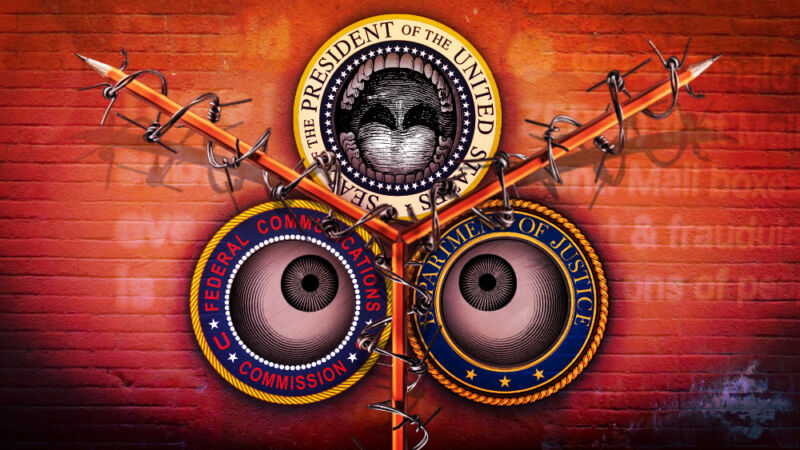
Donald Trump is mad at Twitter, Facebook, and other big technology companies, and in an Oval Office statement on Thursday, he pledged to do something about it.
"A small handful of social media monopolies controls a vast portion of all public and private communications in the United States," he said. "They've had unchecked power to censor, restrict, edit, shape, hide, alter, virtually any form of communication between private citizens and large public audiences."
After his comments, Trump signed an executive order designed to bring social media companies to heel. But Trump has a problem: US law doesn't give the president much actual authority over technology companies. Indeed, the First Amendment arguably prohibits the federal government from second-guessing the editorial decisions of private companies like Facebook, Twitter, and Google.
Over the last year, Trump's advisors have been trying to cobble together a package of initiatives that would respond to Trump's desire for action against Big Tech while staying within the bounds of the law. On Thursday, the president finally signed the result of their efforts. It directs various federal agencies to take steps that penalize big technology platforms for perceived political bias.
Will this strategy work? We put that question to legal scholars and policy insiders in order to game out how the proposed executive order is likely to unfold in practice. While Trump portrays the executive order as the start of a titanic battle between the White House and big technology companies, the practical results may be much less dramatic.
The centerpiece of the order is an effort to strip big technology companies of protection under Section 230, a federal law that immunizes websites against liability for user-submitted content. That would be a big deal if Trump actually had the power to rewrite the law. But he doesn't. Rather, his plan relies on action by the Federal Communications Commission, an independent agency that has shown no inclination to help. Even with FCC help, the most that will happen is a slight reinterpretation of the law—one that the courts might choose to ignore.
The story is similar for other parts of Trump's executive order. Trump wants the Federal Trade Commission to ensure companies are following their own policies on content moderation. That's the same approach the FTC takes with privacy now, and it has proven toothless in practice. Perhaps the most significant change would be redirecting federal ad spending away from big technology platforms. At worst, that would be a modest hit to the bottom lines of technology giants that rake in billions of dollars every quarter.
Section 230: An “unprecedented liability shield”?
The centerpiece of Trump's executive order is a plan to reinterpret a 1996 law that has been instrumental in the growth of the Internet economy. Originally passed as Section 230 of the then-controversial Communications Decency Act, the law gives website owners and Internet service providers broad legal protections against liability for content uploaded by users.
Section 230 says that, for example, if an Ars reader leaves a comment that defames someone, Ars Technica can't be held liable for defamation. Similarly, YouTube, Facebook, and Twitter can't be sued based on the contents of their users' videos, posts, and tweets, respectively. The law also shields sites from liability if they decide to take down content that is "obscene, lewd, lascivious, filthy, excessively violent, harassing, or otherwise objectionable."
The idea behind the law was to promote the growth of the Internet economy while also making sure liability concerns didn't discourage platforms from filtering online content. Previously, some online service providers had taken a hands-off approach because they feared that removing some material would expose them to liability for content they failed to remove. Section 230 was described as a "good Samaritan" law, designed to ease these worries and enable online platforms to filter and moderate online content without worrying about the legal consequences.
Ironically, some pundits and politicians have turned this logic on its head—including President Trump.
"Social media giants like Twitter receive an unprecedented liability shield based on the theory that they are a neutral platform, not an editor with a viewpoint," Trump said in his Oval Office remarks on Thursday. "My executive order calls for new regulations under Section 230 of the Communications Decency Act to make it that social media companies that engage in censoring or any political conduct will not be able to keep their liability shield."
As anyone who has actually read the statute knows, this is simply not an accurate description.
"As the co-author of Section 230, let me make this clear: there is nothing in the law about political neutrality," tweeted Sen. Ron Wyden (D-Ore.), who co-sponsored the law as a young Congressman, on Wednesday.
To the contrary, the explicit goal of Section 230's authors was to free platform owners to make editorial judgments without worrying about the legal ramifications.
The authors of Trump's executive order seem to have a more sophisticated understanding of Section 230 than the president. Rather than peddling outright falsehoods about its content, the document attempts to narrow platforms' Section 230 immunity by focusing on a key requirement of the statute: that a decision to remove objectionable content must be "taken in good faith."
The order claims that social media companies are "invoking inconsistent, irrational, and groundless justifications" to remove content from their platforms. It argues that social media companies lie about their real reasons for removing content and that this means that their filtering decisions are not "in good faith" as required by the statute.
So what is Trump going to do about it? Here's where things get dicey.
reader comments
342